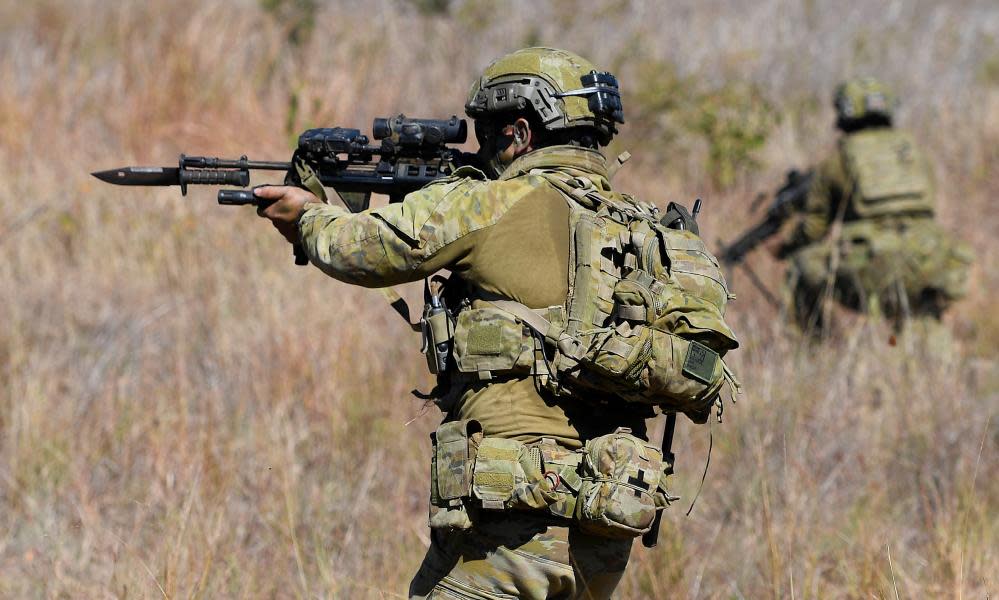Australian defence force strengthens vetting procedures to prevent extremists from joining

The Australian defence force has tightened its vetting procedures in a bid to prevent nationalist and racist violent extremists from joining.
The measures, which include better information sharing with the intelligence agency Asio, are driven by concerns that extremists have sought to join the ADF “to obtain training and capability”.
A defence spokesperson told Guardian Australia the organisation: “Works closely with law enforcement and intelligence agencies to understand and mitigate the threat of ideologically motivated extremism to Defence and within Defence.”
The spokesperson said the new framework “improves upon existing information exchange arrangements between Defence and Asio to assess whether someone is a ‘fit and proper person’ to serve.”
They said questions are asked “to determine whether someone is a ‘fit and proper person’ to serve, which includes a national criminal check and psychological screening of all candidates.”
“In addition, candidates are questioned on their understanding of the meaning and application of Defence values.”
Defence would not comment on the scale of the problem of extremists seeking to join the ADF, including how many individuals may have already been turned away as a result of the updated process.
But Asio disclosed that it had been receiving referrals under a new framework, which it said was introduced in May this year.
“Some nationalist and racist violent extremists seek to join the Australian Defence Force to obtain training and capability,” Asio said in its newly published annual report.
“Asio and Defence have worked closely to ensure Asio security assessment processes can be applied proactively to these individuals.”
The head of Asio, Mike Burgess, has previously expressed concerns about the issue, telling 60 Minutes some neo-Nazis were “absolutely” attempting to join the ADF by concealing their views when recruited.
Email: sign up for our daily morning briefing newsletter
App: download the free app and never miss the biggest stories, or get our weekend edition for a curated selection of the week's best stories
Social: follow us on YouTube, Facebook, Instagram, Twitter or TikTok
Podcast: listen to our daily episodes on Apple Podcasts, Spotify or search "Full Story" in your favourite app
“They can mask that, carry through, get well-trained,” Burgess told Nine in August.
“And when they leave, they’re improved. And that is a concern if they then use that to train others or go to acts of violence themselves.”
The improved screening measures stem from government regulations that set out how a person can be enlisted or appointed in the ADF.
Beforehand, the regulations say, defence is required to consider “whether the person is a fit and proper person to perform duties as such an officer or enlisted member”.
Related: How the ‘good war’ went bad: elite soldiers from Australia, UK and US face a reckoning
In addition, all personnel who apply for an Australian government security clearance face a process that includes an evaluation of risk factors, including “external loyalties, influences and associations”.
Asio now classifies rightwing extremists, including white supremacists and neo-Nazis, under the umbrella category of ideologically motivated violent extremists.
The agency said this category now accounts for about 50% of its priority onshore counter-terrorism caseload, with the remainder being religiously motivated violent extremism.
Asio has expressed concerns about the growing number of young men who are being radicalised by violent ideologies – one of the issues being investigated by a parliamentary inquiry into extremist movements in Australia.
“There has been considerable and understandable attention given to nationalist and racist violent extremism,” Burgess told a Senate estimates hearing on Monday.
“But we are also seeing growth in single-issue motivated groups and individuals that have the potential to embrace violence. We saw this, for example, in the recent anti-lockdown protests, where some adopted violence as a tactic.”

 Yahoo News
Yahoo News 
